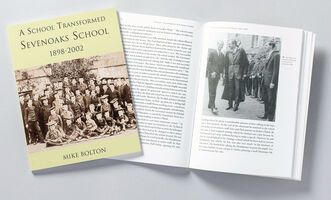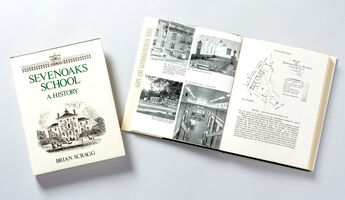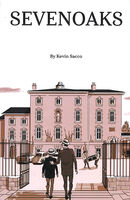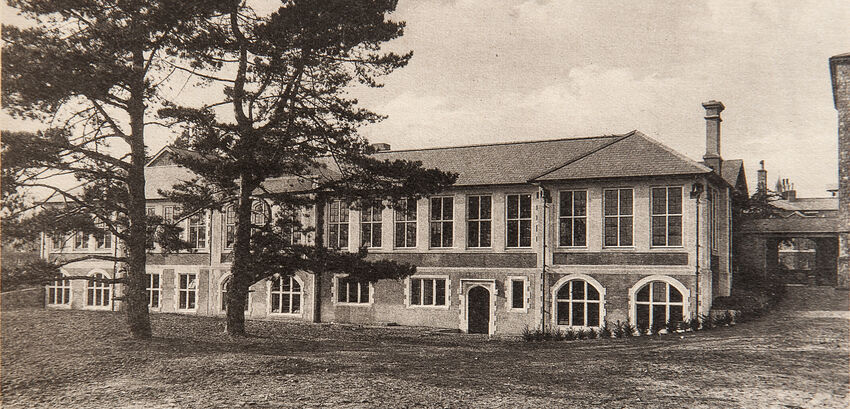The School Archive
Delve into Sevenoaks School's history with the fascinating articles below researched and written by school archivist Sally Robbins.
Several histories of the school by former staff and OS are available to buy:
A School Transformed: Sevenoaks School 1898–2002 by Mike Bolton, former Undermaster
Sevenoaks School: A History by Brian Scragg, former Undermaster
History of Music at Sevenoaks School 1877-2010 by Peter Young, former Head of Music
Sevenoaks written and illustrated by Kevin Sacco (OS 1970)



Email the archivist for queries relating to Sevenoaks School's history, to purchase books or to donate an item to the archive.
Coal Tar Soap and Corrugated Iron

Recollections by Frederick Pearce (OS 1928)
First published in At Honour's Game (Sevenoaks School, 1957)
I joined the school when it had its own Prep, housed in two rooms in the then Sanitorium building (now [1957] known as The Cottage). The Prep boys together with the day-boys and boarders of the main school (no separate Houses then) together numbered under 100, and all were undergoing the trials and tribulations of post-war reconstruction.
The buildings were odd and varied, and each room is associated in my mind with a particular member of the Staff, in themselves a small body but full of character and colour. In the present School House JCR, HJ ‘ Scaly’ Wright held sway over a series of Latin classes; his form lined the walls in order of merit, and you proceeded up or down in a sort of league table fashion. Answers, good or bad, were received by a dry, ‘Quite so, next please,‘ and the sluggards were roused by some accurate chalk throwing.
Whether by accident or design I do not know, but this form room always carried a strong flavour of Wright’s Coal Tar Soap. When his house (Fenton) gained any sporting successes in the summer the team was richly rewarded by a first-rate strawberry tea (is this still done today, I wonder?). One habit of HJW’s which endeared him to the smaller boys was the way in which he always managed to pick up his case with the catch open thus spilling the contents over the desk to their great joy.
Below the JCR was a dank and dismal underground chamber wherein lived a race of junior School House troglodytes whose function was to pounce on the unwary on Match-Day mornings, and to induce them by fair means or foul to ‘volunteer ‘ to watch. The Gym was presided over alternately by TCD [Mr Cleaton Davies] with fine native fire and fervour, dealing with a mixture of Mathematics, Geography and Art, and one James Moss, whose concern was for our physical condition, and whose catch phrases were ‘Light and nimble on the toes‘ and ‘Put those chairs away quietly.’ Because of the shortage of accommodation, two and sometimes three groups of boys occupied the Gym at the same time, but generally the mathematicians were kept apart from the gymnasts. The Gym was also used for morning assembly (when a complete roll-call was taken), plays, concerts and many other purposes. It was smaller than it is today.
Behind the Gym was an ancient Fives Court (since demolished), which was mainly used for day-boys to change in and for general ragging. What is now the day-boys Changing Room was divided into two classrooms, presided over by ‘Ma‘ Collier (History) and Mlle. Fagge (French), and generally the scenes of considerable uproar. Above was the Science Lab where H L (Jockey) White held court, with an acid geniality, dispensing scientific instruction and pungent anecdotes of school history in a balanced mixture. The Lab was approached by an outside iron staircase and landing, and the subject of Jockey’s displeasure was banished to meditate on the landing. Within seconds it almost always happened that the Headmaster (Geoffrey Garrod) would appear, ascend the stairs at speed, firmly grasp the wretched youth’s ear between finger and thumb (the nail of which was kept long and painfully sharp for that very purpose) and drag him back into the Lab for explanations.
The spirit of proper scientific investigation was instilled in the boys of the time by Jockey ‘s teaching, but with results quite unexpected. There was the occasion when a quantity of sodium was placed in each lavatory with very uplifting consequences, and, at another time, one brave spirit placed an article of pottery on the top of the flagstaff to determine the principles of the Laws of Balance. Neither was electricity neglected-at the entrance of the Gym was a switch box with a loose cover, and the drill was to form a number of boys into a half-circle holding hands, when the fellows at each end would link up with the switch box and au appreciable shock was felt by all. At a little later stage the electrical experts evolved a pleasurable alternative to French instruction when use was made of the Schools Broadcast. When the broadcaster came to the words ‘Repeat after me…’ clever and unseen manipulation of wires brought about loud oscillations, which were faithfully repeated by the form as one man.
In what is now the approach to Johnson's Hall [since converted into the Library] stood the Studio (or Hut), a timber and corrugated iron relict of the War, housing the rabble of the Second Form under the Rev. Holland, who taught, among other things, Junior French by means of large coloured posters depicting the four seasons. At the end of the Hut was a small box-like addition, used, I believe, at one time as a Masters’ Common Room and later as a Prefects’ Room.
Although the school buildings have now changed a good deal, many of today’s traditions held good in my time. In particular, singing was as strong then as now. Geoffrey Garrod had a first-rate voice, and contributions at school concerts regularly came in also from HJW (Widdicombe Fair) and HLW (The Mermaid).
Another of the concert notables was the well-loved Claude Hunter, accompanied, as always, by his renowned umbrella. The tradition of good plays also had its origin in the middle twenties, when fine performances were staged under great difficulty and with limited choice of cast.
To begin with, the main games were cricket in the summer and soccer in the winter, some games being played on the Town Recreation Ground at Holly Bush Lane, as the Playing Field at Solefields was not so large as now. At some matches we enjoyed the silent but colourful support of ‘The Tigers,’ three brightly blazered young ladies from Walthamstow Hall.
School cross country running came to the fore in 1922-23 with the advent of YES (Paddy) Kirkpatrick, who made an impressive impact on the school, and who doubled his enthusiasm for athletics with teaching French. Paddy lived in the wilds of Bailey’s Hill, and for extra French tuition one had to slog out there by bicycle, and then, in a state of physical exhaustion, translate a leader from The Times. Paddy introduced rowing into school games, and for a short while a school ‘Four’ was to be seen on the Medway at Tonbridge. His other interests were furious driving, watching aeroplanes from classroom windows, and Russian folk-songs. The latter were sung from time to time at school concerts, and when we could not remember the proper words we made up our own (happily unheard, as I now remember them).
At about the same time, I recall the arrival of another bustling character, ‘Ernie ‘ Groves (EG to my generation), who brought with him an infectious keenness for History and Rugger, which succeeded Soccer in 1924. EG has become another school legend, but I feel his history should come from the pen of a Johnsons’ man. The middle twenties also saw three major changes: the construction of the new Swanzy Buildings (the upper and lower corridors), the departure of one great Headmaster in Geoffrey Garrod and the arrival of another in James Arthur Higgs-Walker. To those younger Sennockians who know ‘Jimmy’ only in his post-1946 mellow period, the man of the 1920s would be regarded in considerable awe. A fast bowler of terrifying mien and approach, five minutes batting against him in the nets was an unforgettable experience-you can keep your Tysons.
These are but odd thoughts recalled by an imperfect memory, but they may inspire others to enlarge on, or correct them, in later issues. There must be a wealth of dormant anecdote amongst the Old Boys.
FC Pearce, 1957
